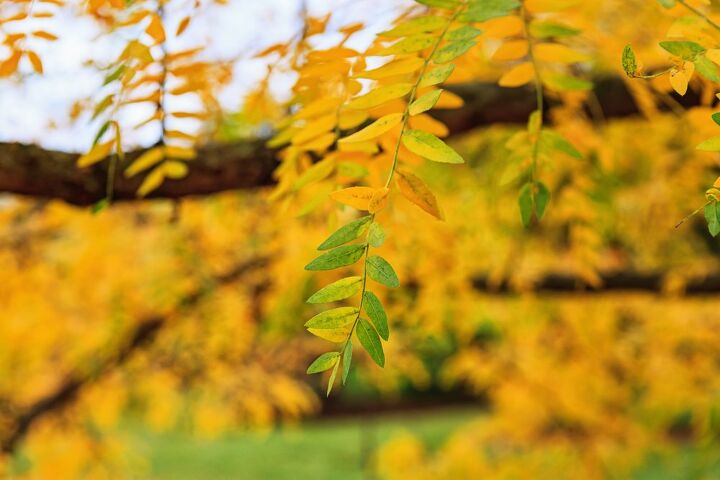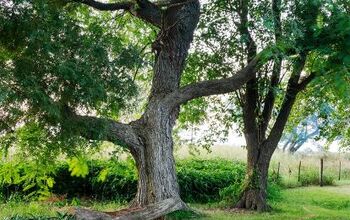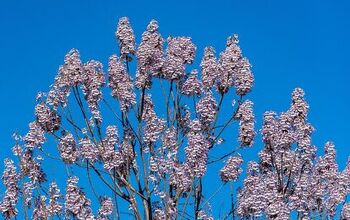What Are The Pros And Cons Of A Thornless Honeylocust Tree?

Thornless honeylocust is a frequently-used tree that’s commonly found in urban areas. It has beautiful yellow leaves in autumn. Plus, thornless honeylocusts provide plenty of dappled shade that still allows grass to grow underneath.
If you’re thinking about planting a thornless honeylocust tree, it’s important to know about its advantages and drawbacks. Some of the pros of thornless honeylocusts are their rapid growth, tolerance to various stressors, and benefits for other wildlife. A couple of the cons of thornless honeylocusts are their messy fruit pods and potential insect issues.
Are you considering planting a thornless honeylocust tree? Before you do so, you’ll definitely want to take a look at all the pros and cons below!
Do You Need Landscaping Services?
Get free, zero-commitment quotes from pro contractors near you.

What Is Thornless Honeylocust?
Thornless honeylocust is a widely-used shade tree that grows in a round or slightly oval shape. It grows quickly and produces fragrant flowers in the springtime.
Thornless honeylocust trees are tolerant to various stressors like pollution, salt, and drought. They prefer full sun and can grow to 30-70 feet tall with a 30-70 foot spread.
When Was The Species Discovered?
The thornless honeylocust tree species was first noted in scientific observations in 1700. The species is native to the area that includes Pennsylvania, Nebraska, and Texas. Today, you can find it in a variety of locations because it’s very adaptable.
Years ago in Tennessee, Cherokees constructed their bows from the thornless honeylocust’s strong, durable wood. More recently, its wood has been favored for fence posts. It also serves as the ideal firewood because it burns slowly at a high temperature.
Where Did Its Name Come From?
The “honey” in honeylocust comes from the sweet substance found in the tree’s fruit pods. Meanwhile, the “locust” comes from the rattling sound that the tree’s dried fruit pods sometimes make.
The native species of honeylocust has thorns. However, as you may have guessed from its name, the thornless honeylocust does not have any thorns.
Pros Of Thornless Honeylocust
There are plenty of reasons why the thornless honeylocust is such a frequently planted tree! Check out the pros of thornless honeylocust trees below.
Rapid Growth
This tree species can grow more than two feet in a single year! Since the thornless honeylocust grows so quickly, you’ll get shade sooner rather than later. This gives thornless honeylocust quite an advantage over some of the slower-growing species of trees.
Tolerant To Stressors
The thornless honeylocust is tolerant to many different stressors. It has moderate tolerance for drought and flooding. Plus, it can handle urban stressors like pollution and road salt. You’ll often see thornless honeylocusts near parking areas and streets for this reason.
Dappled Shade
This type of tree gives dappled shade, providing relief from the sun’s rays. Still, grass and other plants can easily grow underneath a thornless honeylocust. Its filtered shade can act as welcome protection from the heat of the sun. At the same time, it still allows the grass to get the nutrients it needs.
Strong Wood
Thornless honeylocust produces strong, durable wood. It’s much less prone to breakage than wood from other tree species.
Generally Healthy
Overall, thornless honeylocusts are very healthy trees. They’re not susceptible to many diseases aside from Canker. However, Canker is easily prevented with proper care and maintenance.
In general, thornless honeylocusts are low-maintenance and easy to care for. They’re hardy and adaptable, and they aren’t too picky about the environment they grow in.
Easy To Plant And Care For
This species of tree is very easy to plant and grow. Thornless honeylocusts require very little pruning and can mostly be left to their own devices as they mature.
Beautiful Autumn Leaves
In the fall, the thornless honeylocust’s trees turn to a bright shade of yellow. This tree species makes a gorgeous addition to nature’s fall colors. Thornless honeylocusts can definitely add some natural beauty to more urban environments.
Can Adapt To Multiple Soil Types
Thornless honeylocusts are extremely adaptive. They can even grow in multiple different types of soil. These include acidic soil, alkaline soil, and salty soil, as well as both moist and dry soil.
Keeps Hillsides Stable
The thornless honeylocust is a great tree to plant on hillsides. It can contribute to erosion control while also stabilizing poor soil.
Benefits Other Wildlife
Not only is the thornless honeylocust a beautiful addition to your landscaping, it’s also good for other wildlife. For one, its seeds and seed pods are consumed by livestock and other animals like squirrels, deer, and rabbits. Plus, the flowers are a great source of food for bees.
Cons Of Thornless Honeylocust
There are also a few drawbacks to thornless honeylocust trees. Learn more about the cons of this tree species below.
Messy Fruit Pods
Thornless honeylocust has large fruit pods that detach from the tree in the fall. They can cause quite a mess and spread over a large area. There’s a chance this may irritate your neighbors, so you might want to have a chat with them before planting!
Possible Insect Issues
Sometimes, thornless honeylocusts experience insect issues. These can vary from mites to webworms, pod gall midge, plant bugs, and bagworms. However, it’s important to note that these issues are easily prevented. Simply have a tree service spray for bugs a few times each year.
Contributes To Lack Of Species Diversity
The thornless honeylocust is such a popular choice for both city and suburban landscapes that it’s considered overused. Some experts say that it decreases species diversity. Therefore, they recommend that thornless honeylocust trees aren’t planted unless other alternatives have first been considered.
Requires Proper Allocation Of Space
To plant a thornless honeylocust (just like with most trees), it’s important to first check local ordinances. It’s also wise to plan for the tree’s size once it is full-grown. Consider property lines and neighbors’ opinions as well.
How To Plant A Thornless Honeylocust Tree
Here are four simple steps to planting a thornless honeylocust tree.
Step 1: Dig The Hole
The hole should be about three times as wide as the root ball and just as deep. Be sure to roughen up the sides of the hole so that it’s easier for the tree’s roots to take hold.
Step 2: Detangle The Roots
As a general rule, try to avoid disturbing the roots as much as you can. But if they’ve started to form around the root ball or pot, it’s best to loosen them a bit. This way, it’ll be easier for the roots to grow out into the soil rather than circling.
Step 3: Backfill The Hole
Set the tree into the hole you dug in Step 1. Ensure that the soil line remains the same. This means that the soil should hit the tree at the same point as it did in the container.
Next, backfill the hole with the original soil about halfway. Fill the rest of the hole with water and wait for it to soak into the soil. Follow up by filling the rest of the hole with soil and firming the soil to eliminate any air pockets.
Step 4: Add Mulch
Add two to four inches of organic mulch on top of the soil. Try to keep the mulch from touching the tree’s trunk since it can damage the bark. Then you can essentially leave the tree alone to grow for the next couple of years before doing any pruning.
Related Questions
Is thornless honeylocust good for firewood?
Thornless honeylocust works well as firewood. In fact, it’s considered the optimal firewood! It puts out a lot of heat, burns slowly, and is easy to split.
Does thornless honeylocust have pods?
Yes, thornless honeylocust has pods. In the fall, these pods detach from the tree and can make quite a mess.
How fast does a thornless honeylocust grow?
Thornless honeylocusts grow very quickly. This tree species can grow more than two feet in one year!
Do You Need Landscaping Services?
Get free, zero-commitment quotes from pro contractors near you.

Main Takeaways
- The thornless honeylocust is a popular tree species that’s often planted in urban areas because it’s so adaptable and resistant to urban stressors.
- In some areas, it’s not recommended to plant thornless honeylocusts because they contribute to a lack of species diversity.
- Thornless honeylocusts are easy to plant and take care of. They can grow more than two feet in a year and can survive in many different types of soil.
- One drawback to thornless honeylocusts is that their fruit pods can create a mess in the fall. They have a tendency to end up everywhere, including your neighbors’ yards.
- Thornless honeylocusts benefit other types of wildlife, such as deer, rabbits, and bees. However, they can also attract other insects, which can potentially cause issues. As long as a tree service sprays your thornless honeylocust a few times each year, you shouldn’t have a problem.

With a lifelong passion for writing plus strong enthusiasm for home improvement and DIY projects, joining the team at Upgraded Home was an easy choice. Jessica Allen likes to share helpful information with current and aspiring homeowners. Aside from writing, Jessica loves doing yoga, playing the piano, and dabbling in graphic design.
More by Jessica Allen














![10 Best Cordless Leaf Blowers – [2022 Reviews & Ultimate Guide]](https://cdn-fastly.upgradedhome.com/media/2023/07/31/9070789/10-best-cordless-leaf-blowers-2022-reviews-ultimate-guide.jpg?size=350x220)











![Standard Dining Room Table Dimensions [for 4, 6, 8, 10 and 12 People]](https://cdn-fastly.upgradedhome.com/media/2023/07/31/9074335/standard-dining-room-table-dimensions-for-4-6-8-10-and-12-people.jpg?size=350x220)
